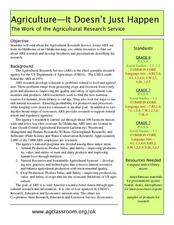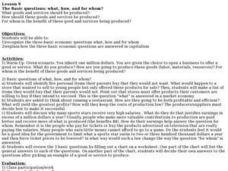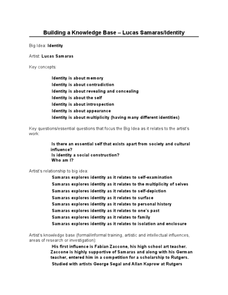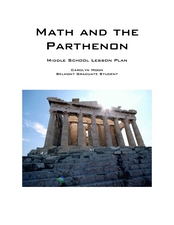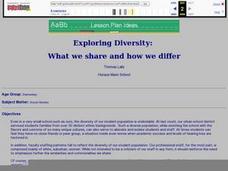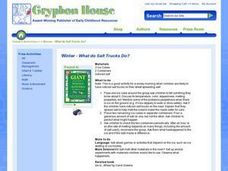Curated OER
The Customer Service Chain
Students identify and interpret the importance of customer service.
Then they identify the concept of customer chain and the meaning of the quality paradigm. Students also identify and define the role of quality in competitiveness and...
Curated OER
Customer Service Skills
Students discuss and identify customer service skills. They examine customer's notions of justice and the three types of customer service delivery. They role-play different scenerios as well.
Curated OER
Issues and Complications of Delivering Quality Customer Service
Students identify how tourism organizations can improve their customer service. They examine the benefits that customer service can bring to the business. They use this knowledge and compare it to a passenger airline.
EngageNY
Why Do Banks Pay YOU to Provide Their Services?
How does a bank make money? That is the question at the based of a lesson that explores the methods banks use to calculate interest. Groups compare the linear simple interest pattern with the exponential compound interest pattern.
Curated OER
Agriculture: It Doesn't Just Happen
After reading an informational text on the Agricultural Research Service, learners research the role of the ARS in Oklahoma. Using reputable online sources, they label a map of the state with relevant areas. Researchers focus on one of...
Mathematics Assessment Project
Fearless Frames
Show class members how to connect algebra to geometry. A high school assessment task has pupils determine volumes of two different containers given limitations on material for box frames. Pupils then write a paragraph on...
Curated OER
Manners and Etiquette Day 2
Practice correct table setting procedures and identify acceptable manners and etiquette skills to be used with meal service. Your class will practice table manners and introductions and create a real working atmosphere with customers....
Curated OER
Project-Based Learning: Diversity
Ethnic and cultural diversity are explored in a service learning lesson, great for upper graders. They participate in four weekly activities that require them to research ethnic and cultural diversity.
Curated OER
The Basic Questions: What, How, and For Whom?
Students review the various types of economic systems. As a class, they identify the three basic economic questions: what?, How?, and For Whom?. Using capitalism as an economic system, they discuss how each question is answered.
Curated OER
The Egg Drop
Students design and create a container that allows a raw egg to drop from the second floor of a building without breaking. They develop and compute an invoice for project expenses using spreadsheet software. Students role-play a proposal...
Curated OER
Demonstrate Selling Skills in Travel and Tourism Contexts
Students examine how different organizations use selling. They interpret data and analyze customer needs. They practice their selling skills in a sports tourism market.
Curated OER
Native American Ceremonies
Second graders explore cultural rituals by researching Native American people. In this Native American ceremony lesson, 2nd graders read the story Indian Festivals by Keith Brand and identify the naturalistic attitude of the Native...
Curated OER
The Development of the Cruise Sector
Learners examine the structure of the cruise sector. They identify the main characters and analyze customer demand for this type of service. They discover agencies who regulate the cruise sector as well.
Mascil Project
Packaging
Wrap up an engineering lesson with a worthwhile project. An engineering design task challenges groups to develop a package for a pharmaceutical company given constraints on the volume. Learners then create a presentation to highlight...
National Science Teacher Association
Middle School Sampler: Science
Focus on inquiry-based learning in your science class with a series of activities designed for middle schoolers. A helpful packet samples four different texts, which include activities about predator-prey relationships, Earth's axis...
Curated OER
Building a Knowledge Base - Lucas Samaras/Identity
Bring art into your classroom with this resource for teaching the concept of identity through Lucas Samaras' identity boxes. Use this list of information to help plan out a unit on identity as demonstrated through art. While not...
Rochester Institue of Technology
Meal Picking
Scholars explore systems design and its relation to meal picking by using computer simulations to test systems designs. They learn about the Pick-to-Light System and calculate average picking times.
Curated OER
Summertime -- Camping Memory Game
Students discuss the items needed to camp outside. They identify objects in a backpack and tell what the item could be used for. They hide the objects throughout the room and they are to find them.
Curated OER
Math and the Parthenon
Students relate math to different areas of construction. In this algebra lesson, students identify the relationship between shapes and the way math is used in architecture. They investigate properties of the Parthenon as it relates to...
Curated OER
Exploring Diversity: What We Share and How We Differ
Students discuss the amount of diversity at their school. They examine a culture other than their own and share it with their classmates. They discuss the importance of diversity to end the instructional activity.
Curated OER
Growing Money
Fourth graders sell plants. In this business lesson students propagate plants from cuttings. Students create a business to sell the plants they grow.
Curated OER
Paws in Jobland: Shopping Center Quiz
Students develop research skills and the use of computer-based information. In this career lesson plan, students understand the variety of jobs there are in an area of work.
Curated OER
Water Usage
Discuss how much water an individual might use for a shower, brushing teeth, and other activities. The website containing actual water use data for comparison is not valid, but perhaps you can find another by a quick internet search. At...
Curated OER
What Do Salt Trucks Do?
Students predict what will happen to ice when salt is put on it. They make observations and discuss what actually happened to the ice. They relate their experiment to the salt trucks they see on the street.




